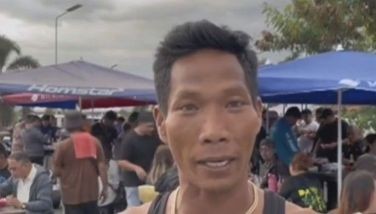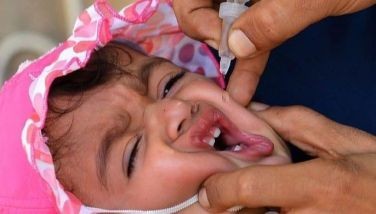Water a pressing concern for typhoon survivors
TACLOBAN, Philippines — Since the typhoon hit, Danny Estember has been hiking three hours round-trip into the mountains each day to obtain what he can only hope is clean water for his five daughters and two sons.
The exhausting journey is necessary because safe water is desperately scarce in this storm-ravaged portion of the Philippines. Without it, people struggling to rebuild and even survive risk catching intestinal and other diseases that can spread if they're unable to wash properly.
While aid agencies work to provide a steady supply, survivors have resorted to scooping from streams, catching rainwater in buckets and smashing open pipes to obtain what is left from disabled pumping stations. With at least 600,000 people homeless, the demand is massive.
"I'm thirsty and hungry. I'm worried — no food, no house, no water, no money," said Estember, a 50-year-old ambulance driver.
Thousands of other people who sought shelter under the solid roof of the Tacloban City Astrodome also must improvise, taking water from wherever they can — a broken water pipe or a crumpled tarp. The water is salty and foul tasting but it is all many have had for days.
The U.S. Institute of Medicine defines an adequate daily intake of fluids as roughly 3 liters (100 ounces) for men and about 2.2 liters (75 ounces) for women. Given the shortages and hot climate, it's certain that most in the disaster zone aren't getting anything like those amounts, leaving them prone to energy-sapping dehydration.
Providing clean, safe drinking water is key to preventing the toll of dead and injured from rising in the weeks after a major natural disaster. Not only do survivors need to stay hydrated, they also need to be protected from waterborne diseases such as cholera and typhoid.
Haiti's devastating 2010 earthquake was followed by a cholera outbreak that health officials say has killed more than 8,000 people and sickened nearly 600,000. Some studies have shown that cholera may have been introduced in Haiti by U.N. troops from Nepal, where the disease is endemic.
Washing regularly, using latrines and boiling drinking water are the best ways to avoid contracting diarrhea and other ailments that could burden already stressed health services.
It took several days for aid groups to bring large quantities of water to Tacloban, the eastern Philippine city where the typhoon wreaked its worst destruction. By Friday, tankers were arriving. Philippine Red Cross workers sluiced water into enormous plastic bladders attached to faucets from which people fill jerry cans, buckets, bottles and whatever other containers they might have.
"I'm thirsty," said Lydia Advincula, 54, who for the last few days had been placing buckets out doors to catch some of the torrential downpours that have added to the misery of homeless storm survivors.
Water provisioning should get a big boost with the recent arrival of the U.S. Navy aircraft carrier USS George Washington, a virtual floating city with a distillation plant that can produce 1.5 million liters (400,000 gallons) of fresh water per day — enough to supply 2,000 homes, according to the ship's website.
Britain also is sending an aircraft carrier, the HMS Illustrious, with seven helicopters and facilities to produce fresh water, Britain's Ministry of Defense said. It said the ship is expected to reach the area about Nov. 25.
Filtration systems are now operating in Tacloban, the center of the relief effort, and two other towns in Leyte province, the hardest-hit area. Helicopters are dropping bottled water along with other relief supplies to more isolated areas.
Other more high-tech water purification solutions are also available, such as water purification bottles developed since the 2004 Indian Ocean tsunami that devastated parts of Thailand, Indonesia, India and Sri Lanka. Those contain systems that filter out parasites, bacteria and other dangerous substances from virtually any water source, making it safe to drink and alleviating the high cost and logistical difficulties that shipping in bottled water entails.
Longer-term water solutions will come once the crucial issues of shelter and security are settled and will likely have to wait several months, said John Saunders, of the U.S.-based International Association of Emergency Managers. Those water systems are far more complex, requiring expensive, specialized equipment and training for operators, he said.
"I can bring in a $300,000 water system that provides thousands of liters per day of drinking water, but who pays for the system and how is it maintained and distribution managed?" Saunders said.
Long-term solutions are a distant concern for Jaime Llanera, 44, as he stands in a shelter he and his family have fashioned out of broken plywood and a tarpaulin.
A single 500-milliliter (12-ounce) bottle of mineral water delivered by the military three days earlier is all that's available for his parents, sister, brother-in-law and a friend. To stretch their supply, they've been collecting rainwater in buckets and any other containers they can find and boiling it. They're also using rainwater to clean: His mother dunks clothing into a bucket of rainwater and tries to scrub out the filth.
The family plans to wait one more week. If help hasn't come by then, they'll try to find a way out of Tacloban so they can stay with relatives elsewhere. "We have no house. We have no home. But we're still intact," Llanera said.
- Latest
- Trending
























